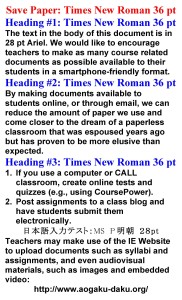As much as possible, we would like to encourage teachers to strive for a paperless classroom. Professor Yokotani has offered a great idea toward making that a reality. Almost all teachers provide students with many handouts throughout the year. We can cut down our use of paper by making available, at least, some of those handouts online, either through a course website or by sending them directly to students through email (after setting up a mailing list).
The idea put forward by Professor Yokotani was for teachers to create smartphone-friendly handouts for students using a template document optimized for comfortable viewing on a smartphone. These days, a majority of the students in our classes possess smartphones of one kind or another, so this is an idea whose time has come.
Using Microsoft Word, you can produce a smartphone-friendly document by using these specs:
Margins = upper 5 mm, lower 5 mm, left 6.1 mm, right 6.1 mm
Header position = 4 mm from the top
Footer = None
English font = Ariel, 28 pt
Japanese font (if Japanese is used in the doc) = MS P Mincho, 28 pt
Font type and size for header and headings = Times New Roman 36
After the document has been saved using Word, it is recommended that it be converted to a PDF so that you can be sure that students will see it as you do. It should be viewable on most smartphones without the need for resizing, allowing for the efficient swiping between the pages of the document.
DOCUMENT TEMPLATE
EXAMPLE OF PDF CREATED FROM THE TEMPLATE (Try downloading to a smartphone to test it for readability)
You can suggest that students download and use the free smartphone (or tablet) app “Adobe Reader” for their iOS or Android device. That way they will be able to store all the documents they receive in one convenient place and view them comfortably.
The following documents, prepared by Prof. Yokotani of the IE Committee, explain in detail how to view PDF documents on mobile devices. They have been formatted to appear nicely on mobile devices and they offer a step by step explanation of how teachers and students may view them on iOS or Android devices. Although the files will appear long and skinny on smartphones and tablets, they facilitate continuous scrolling and allow users to print out four pages of the document on one A4-sized paper.

